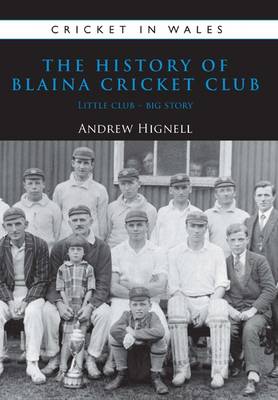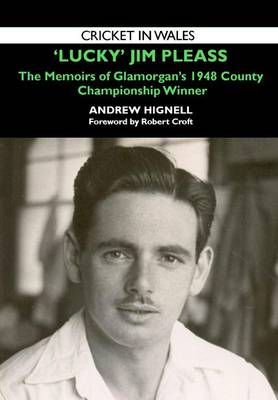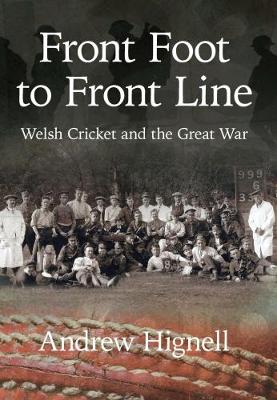Cricket in Wales
3 primary works
Book 1
Written by Andrew Hignell, the Archivist of Glamorgan County Cricket Club and the leading authority on the history of cricket in Wales, this book recalls these Golden Years in the history of Blaina Cricket Club as well as tracing the fascinating history of cricket in this Monmouthshire valley. Drawing on the memories, photographs and personnel recollections of those directly involved with the Blaina club from the times when coal was king, through the years of the decline in the iron and tinplate industry to the modern years of mine closure and de-industrialisation, Andrew Hignell has not only produced a cricketing history of Blaina, but also a social history of the town. Cricket began in Blaina in the 1850s as the ironmasters used the game to fly the flag for their works as well as trying to harmonise industrial relations and promoting healthy lifestyles. The playing of cricket subsequently developed into a unifying force within the tight-knit valley communities and, as the first team-game to evolve in industrial Wales, it helped to bond and give immense pleasure to the people whose livelihood was dominated by the state of the iron and coal industries.
There were good times and bad, yet throughout the nineteenth and twentieth centuries the Blaina cricket club remained strong and vibrant. It was a founding member of the South Wales and Monmouthshire League and the club regularly attracted large crowds, sometimes of up to 4,000.
There were good times and bad, yet throughout the nineteenth and twentieth centuries the Blaina cricket club remained strong and vibrant. It was a founding member of the South Wales and Monmouthshire League and the club regularly attracted large crowds, sometimes of up to 4,000.
Book 2
Jim Pleass is the last surviving member of Glamorgan's County Championship winning team of 1948, the first time the Welsh team won the highest honour in county cricket. The Cardiff-born multi-talented sportsman, who was also an exceptional footballer and offered trial games for Cardiff City as a schoolboy, built a reputation as a solid and reliable team player at a time when Glamorgan was establishing itself on the first class cricket scene after the Second World War. In stark contrast to contemporary sport which is too often dominated by money and celebrity, Jim was a hard-working professional sportsman typical of his era, who simply enjoyed the camaraderie and of the game he loved. Yet the man who was born in Cardiff in 1923 achieved something that only a handful of the five hundred or so people who have proudly worn the daffodil-sweater since the Club's formation in 1888, can claim to have also matched, winning some sixty summers after the Club's creation their first-ever County Championship title. Jim was a very lucky man, as the book explains his narrow escape from certain death when he stormed the Normandy beaches on D day in 1944.
If it wasn't for the over-exuberance of a driver on another landing craft, Jim would never have graced the cricket field wearing the daffodil of Glamorgan County Cricket Club.
If it wasn't for the over-exuberance of a driver on another landing craft, Jim would never have graced the cricket field wearing the daffodil of Glamorgan County Cricket Club.
Book 3
Front Foot to Front Line commemorates Welsh cricket's contribution to the Great War by chronicling the lives of 55 professional and amateur cricketers who left the friendly rivalry of the crease for the brutality and horror of the trenches, and lost their lives as servicemen on the bloody battlefields of Europe.
The distinguished author and the leading authority on Welsh cricket, Andrew Hignell, traces the major themes and battles of the First World War to provide a poignant snapshot of how Wales lost a generation of young men who were united by their love of cricket and their courage to serve their country.
Front Foot to Front Line not only pays tribute to the cricketers, drawn from over 35 local clubs across Wales, who lost their lives but also to those who returned home permanently affected by their experiences of warfare. The book also highlights the involvement of many characters involved at the grassroots of Welsh club cricket who served with distinction and will be of great interest to the large Welsh cricketing fraternity as well as to those with an interest in military history.
The cricket clubs featured in Front Foot to Front Line include:
Blaina, Barry, Brecon, Bridgend Town, Briton Ferry, Cardiff, Cowbridge, Crickhowell, Denbighshire, Ferndale, Garth, Glamorgan, Llancarfan, Llandovery College, Llandudno, Llanelli, Monmouthshire, Neath, Newport, Pontypridd, Radyr, Swansea, Usk Valley, and Ystrad Mynach.
The distinguished author and the leading authority on Welsh cricket, Andrew Hignell, traces the major themes and battles of the First World War to provide a poignant snapshot of how Wales lost a generation of young men who were united by their love of cricket and their courage to serve their country.
Front Foot to Front Line not only pays tribute to the cricketers, drawn from over 35 local clubs across Wales, who lost their lives but also to those who returned home permanently affected by their experiences of warfare. The book also highlights the involvement of many characters involved at the grassroots of Welsh club cricket who served with distinction and will be of great interest to the large Welsh cricketing fraternity as well as to those with an interest in military history.
The cricket clubs featured in Front Foot to Front Line include:
Blaina, Barry, Brecon, Bridgend Town, Briton Ferry, Cardiff, Cowbridge, Crickhowell, Denbighshire, Ferndale, Garth, Glamorgan, Llancarfan, Llandovery College, Llandudno, Llanelli, Monmouthshire, Neath, Newport, Pontypridd, Radyr, Swansea, Usk Valley, and Ystrad Mynach.


